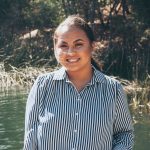by Keziah Aurin ’22
I remember my interview for the Undergraduate Library Fellowship very vividly. Kristina and Nicole, the kindest people on Earth and the program coordinators asked me about my experience in design and how I would like to use it in the fellowship. I said something along the lines of, “I have no idea but I want to use design to solve problems in my community.” To my surprise, I am now wrapping up my fellowship with this blog post!
Coming into the fellowship, I thought we would dive right into determining issues or things to improve on in the Library and finding solutions addressing them. I could not be any more wrong. Throughout these past eight-ish months, we placed a lot of focus on learning and truly grasping what it means to center humans in our designs and to make solutions accessible, effective, and long-lasting. It became more about us growing than us producing.
During the fall semester, the mentors took the time to help us understand and engage with human-centered design. We participated in workshops, open discussions, and activities to immerse ourselves in what it is like to 1) face problems, big and small, fictional and realistic, and; 2) develop methodical solutions out of them. In addition, our mentors also helped us ground ourselves and our thinking in radical self-love and radical community care. Through our discussion on Emergent Strategy and activity on Rapid Prototyping, we had the opportunity to not only define, but also actualize empathetic and selfless problem-solving.
Translating that to our spring semester project, I, along with my amazing partner, Natalie, put together a survey aiming to address disparities within the library and its relationship with marginalized undergraduate students. We hoped to gain a better understanding of why student organizations tend to offer their own services similar to the library such as research support, book banks, and even study spaces. More importantly, we wanted to highlight these existing resources, through the library, using a Notion database to make it user-friendly and easy to access for our target audience.
As I sit in front of my computer and write this reflection, I can’t help but think that perhaps we don’t need crazy ideas to address problems around us. Instead, it’s far more crucial that we slow down to think, listen, reflect, understand, and try to take advantage of the people, skills, and resources already in front of us. This fellowship and every single person that I got to work with (Jen, Annalise, and Natalie- you all have my heart!) have transformed my design thinking and problem-solving processes drastically. To put it bluntly, I am no longer a let’s-get-right-down-to-business type gal. Instead, I am now a let’s-sit-down-and-reflect type of leader.
I think that’s what we need more of: spaces and people that encourage us to learn and explore, shifting away from productivity and towards the journey. After a heavy year full of turbulence, turmoil, and uncertainty, I found a (virtual) safe haven every other Monday afternoon where I was allowed to think critically, ask loudly, and solve empathetically. Sometimes all we need is a space fast-paced enough that we don’t let the world pass by us but slow enough that it still allows us to reflect and still be human.